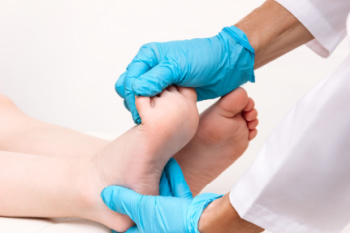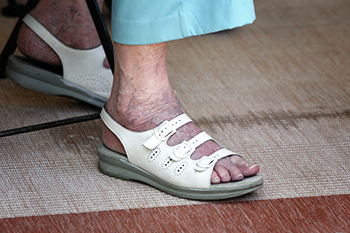Items filtered by date: May 2024
Lower Limb and Foot Injuries in Athletic Children
 Lower limb and foot injuries are common in athletic children, partly due to the vulnerability of their growth plates. Growth plates are the developing areas of cartilage at the end of the long bones in the legs where bone growth takes place. These plates are weaker than nearby tendons and ligaments, making them more susceptible to injury. This is especially true when under the stress of repetitive physical activities in sports. Movements like running, jumping, and quick pivoting can place excessive strain on growth plates, leading to conditions such as Sever's disease, or heel pain. Ankle sprains are also common because ligaments in children tend to be more elastic than in adults. The biomechanics of growing children, such as variations in gait, muscle strength, and coordination during growth spurts, can further predispose them to these injuries as their bodies adapt to rapid physical changes. A podiatrist, or foot doctor, can treat these types of injuries common in active children. They may suggest treatments ranging from rest and elevation to custom orthotics that support proper alignment and reduce stress on the growth plates. Treatments vary depending on the injury. If your child is struggling with a lower limb or foot injury, it is suggested you consult with a podiatrist for targeted care.
Lower limb and foot injuries are common in athletic children, partly due to the vulnerability of their growth plates. Growth plates are the developing areas of cartilage at the end of the long bones in the legs where bone growth takes place. These plates are weaker than nearby tendons and ligaments, making them more susceptible to injury. This is especially true when under the stress of repetitive physical activities in sports. Movements like running, jumping, and quick pivoting can place excessive strain on growth plates, leading to conditions such as Sever's disease, or heel pain. Ankle sprains are also common because ligaments in children tend to be more elastic than in adults. The biomechanics of growing children, such as variations in gait, muscle strength, and coordination during growth spurts, can further predispose them to these injuries as their bodies adapt to rapid physical changes. A podiatrist, or foot doctor, can treat these types of injuries common in active children. They may suggest treatments ranging from rest and elevation to custom orthotics that support proper alignment and reduce stress on the growth plates. Treatments vary depending on the injury. If your child is struggling with a lower limb or foot injury, it is suggested you consult with a podiatrist for targeted care.
The health of a child’s feet is vital to their overall well-being. If you have any questions regarding foot health, contact Harris Greenberger, DPM of Fairfield County Foot Surgeons. Our podiatrist can provide the care you need to keep you pain-free and on your feet.
Tips for Keeping Children's Feet Healthy
- Make sure their shoes fit properly
- Look for any signs of in-toeing or out-toeing
- Check to see if they have Clubfoot (condition that affects your child’s foot and ankle, twisting the heel and toes inward) which is one of the most common nonmajor birth defects.
- Lightly cover your baby’s feet (Tight covers may keep your baby from moving their feet freely, and could prevent normal development)
- Allow your toddler to go shoeless (Shoes can be restricting for a young child’s foot)
- Cut toenails straight across to avoid ingrown toenails
- Keep your child’s foot clean and dry
- Cover cuts and scrapes. Wash any scratches with soap and water and cover them with a bandage until they’ve healed.
If you have any questions, please feel free to contact our office located in Norwalk, CT . We offer the newest diagnostic and treatment technologies for all your foot care needs.
Reasons Why Your Big Toe Is Numb

Numbness in the big toe can be a perplexing sensation, ranging from a slight tingling to a complete loss of feeling. While big toe numbness might seem like a minor inconvenience at first, it could be a sign of underlying issues that need attention. One of the most common causes is wearing shoes that are too tight. Footwear that constricts the toes can impede circulation and lead to numbness. Conditions that involve stiffness in the joint at the base of the big toe are often accompanied by bone spurs that may press on nerves, causing numbness. Nerve damage, often associated with conditions like diabetes or autoimmune diseases, also can result in numbness, tingling, or pain in the toes. A bunion, which is a bony bump at the base of the big toe can exert pressure on surrounding nerves and lead to numbness. Exposure to freezing temperatures can damage tissues, causing numbness in the toes. Finally, Raynaud’s disease, a vascular condition that results in spasms in small arteries of the feet, can lead to numbness and discoloration in the toes, particularly in response to cold or stress. If you are experiencing persistent numbness in your big toe, it is suggested that you schedule an appointment with a podiatrist for a thorough exam and treatment options based on the results.
Neuropathy
Neuropathy can be a potentially serious condition, especially if it is left undiagnosed. If you have any concerns that you may be experiencing nerve loss in your feet, consult with Harris Greenberger, DPM from Fairfield County Foot Surgeons. Our podiatrist will assess your condition and provide you with quality foot and ankle treatment for neuropathy.
What Is Neuropathy?
Neuropathy is a condition that leads to damage to the nerves in the body. Peripheral neuropathy, or neuropathy that affects your peripheral nervous system, usually occurs in the feet. Neuropathy can be triggered by a number of different causes. Such causes include diabetes, infections, cancers, disorders, and toxic substances.
Symptoms of Neuropathy Include:
- Numbness
- Sensation loss
- Prickling and tingling sensations
- Throbbing, freezing, burning pains
- Muscle weakness
Those with diabetes are at serious risk due to being unable to feel an ulcer on their feet. Diabetics usually also suffer from poor blood circulation. This can lead to the wound not healing, infections occurring, and the limb may have to be amputated.
Treatment
To treat neuropathy in the foot, podiatrists will first diagnose the cause of the neuropathy. Figuring out the underlying cause of the neuropathy will allow the podiatrist to prescribe the best treatment, whether it be caused by diabetes, toxic substance exposure, infection, etc. If the nerve has not died, then it’s possible that sensation may be able to return to the foot.
Pain medication may be issued for pain. Electrical nerve stimulation can be used to stimulate nerves. If the neuropathy is caused from pressure on the nerves, then surgery may be necessary.
If you have any questions, please feel free to contact our office located in Norwalk, CT . We offer the newest diagnostic and treatment technologies for all your foot care needs.
How Aging Can Affect Your Feet

As people age, their feet bear the brunt of a lifetime of activity, an accumulation of wear and tear that can lead to various problems. Women over 50 are particularly prone to foot issues as they age. These are caused by hormonal changes, decreased bone density, and the effects of wearing high heels. The soft tissues in the feet lose elasticity over time, making older adults more susceptible to conditions like Achilles tendonitis and plantar fasciitis. Among the foot problems associated with aging are stress fractures, plantar fasciitis, and bunions, flat feet, and osteoarthritis, which can hinder mobility and cause discomfort, are other ailments common among seniors. While simple measures like wearing supportive shoes and engaging in low-impact exercises can alleviate symptoms, persistent foot pain necessitates professional attention from a podiatrist, or a foot and ankle specialist, to prevent further complications. If you are an older adult who is experiencing foot or ankle pain, it is suggested that you make an appointment with a podiatrist for an exam and treatment.
Proper foot care is something many older adults forget to consider. If you have any concerns about your feet and ankles, contact Harris Greenberger, DPM from Fairfield County Foot Surgeons. Our podiatrist can provide the care you need to keep you pain-free and on your feet.
The Elderly and Their Feet
As we age we start to notice many changes in our body, but the elder population may not notice them right away. Medical conditions may prevent the elderly to take notice of their foot health right away. Poor vision is a lead contributor to not taking action for the elderly.
Common Conditions
- Neuropathy – can reduce feeling in the feet and can hide many life-threatening medical conditions.
- Reduced flexibility – prevents the ability of proper toenail trimming, and foot cleaning. If left untreated, it may lead to further medical issues.
- Foot sores – amongst the older population can be serious before they are discovered. Some of the problematic conditions they may face are:
- Gouging toenails affecting nearby toe
- Shoes that don’t fit properly
- Pressure sores
- Loss of circulation in legs & feet
- Edema & swelling of feet and ankles
Susceptible Infections
Diabetes and poor circulation can cause general loss of sensitivity over the years, turning a simple cut into a serious issue.
If you have any questions please feel free to contact our office located in Norwalk, CT . We offer the newest diagnostic and treatment technologies for all your foot and ankle needs.
Definition and Causes of Bunionettes

Bunionettes, also known as tailor's bunions, are bony bumps that develop on the outside of the foot, near the base of the pinky toe. Understanding the definition and underlying causes of these foot deformities is vital for effective management and prevention. Essentially, a bunionette forms when the bone at the base of the fifth toe protrudes outward, often accompanied by the misalignment of the toe joint. This condition is primarily attributed to structural imbalances in the foot, including inherited foot shapes, abnormal foot mechanics, or wearing narrow shoes that compress the toes. Over time, pressure and friction on the affected area can exacerbate the deformity, leading to pain, inflammation, and difficulty wearing certain footwear. While bunions and bunionettes share similar characteristics, they affect different areas of the foot. Bunionettes typically develop on the outer edge of the foot, whereas bunions occur at the base of the big toe. If you have developed a bunion or bunionette, it is suggested that you visit a podiatrist who can determine what the best course of treatment is for you.
If you are suffering from bunion pain, contact Harris Greenberger, DPM of Fairfield County Foot Surgeons. Our podiatrist can provide the care you need to keep you pain-free and on your feet.
What Is a Bunion?
Bunions are painful bony bumps that usually develop on the inside of the foot at the joint of the big toe. As the deformity increases over time, it may become painful to walk and wear shoes. Women are more likely to exacerbate existing bunions since they often wear tight, narrow shoes that shift their toes together. Bunion pain can be relieved by wearing wider shoes with enough room for the toes.
Causes
- Genetics – some people inherit feet that are more prone to bunion development
- Inflammatory Conditions - rheumatoid arthritis and polio may cause bunion development
Symptoms
- Redness and inflammation
- Pain and tenderness
- Callus or corns on the bump
- Restricted motion in the big toe
In order to diagnose your bunion, your podiatrist may ask about your medical history, symptoms, and general health. Your doctor might also order an x-ray to take a closer look at your feet. Nonsurgical treatment options include orthotics, padding, icing, changes in footwear, and medication. If nonsurgical treatments don’t alleviate your bunion pain, surgery may be necessary.
If you have any questions, please feel free to contact our office located in Norwalk, CT . We offer the newest diagnostic and treatment technologies for all your foot care needs.

